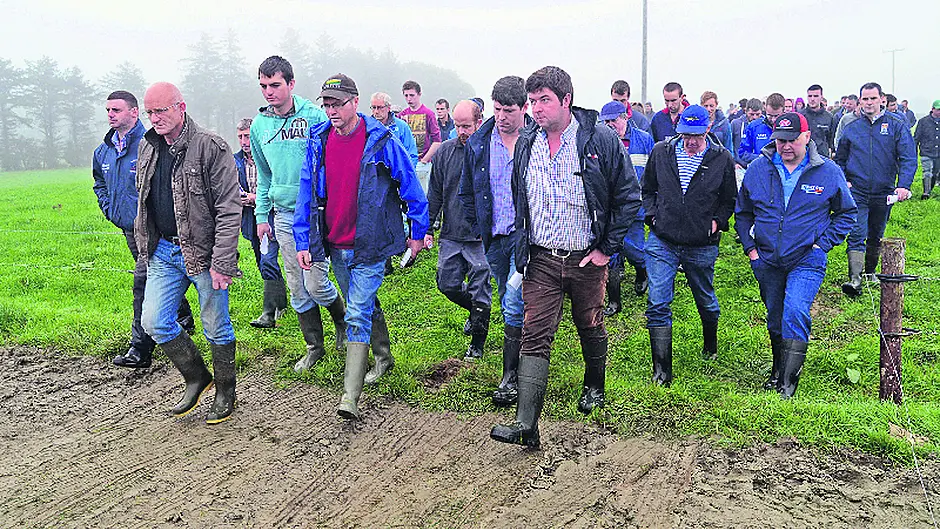Despite the misty and cloudy conditions on the morning of Thursday, September 15th, a large group of young farmers attended the farm walk at the Shinagh dairy farm, near Bandon.
BY JOHN SEXTON
DESPITE the misty and cloudy conditions on the morning of Thursday, September 15th, a large group of young farmers attended the farm walk at the Shinagh dairy farm, near Bandon.
Welcoming everybody, Billy Kelleher, Teagasc regional manager for West Cork, said that the main purpose of the event was to make farmers aware of the means by which they could extend the grazing season with proper grassland management from here to the end of the year. In the year that is in it, with cashflow a problem on many farms, it is imperative that every avenue is pursued towards improving production.
The event was sponsored by AIB Bank and their local agricultural adviser, Donal Whelton, said that it is widely accepted that we have entered a new era in Irish dairy farming – an era in which dairy farmers have the opportunity to exploit our competitive advantage in grass-based production, but in an environment which is more volatile, and where traditional EU policy supports are less prevalent. Present also was a group of AIB personnel, some having come from as far away as Co Westmeath.
The chairman of Shinagh Estates, Gerard McCarthy, in an address of welcome, said that the four West Cork co-ops are partners in this demonstration farm, along with Teagasc. He went on to say that the aim is to examine the issues related to operating a dairy herd, financial management, cows, people and grass to make it possible and, above all, how to make a profit. By doing this and showing you the issues that will arise, it will help all dairy farmers, he added.
It was a brave decision of the board of Shinagh Estates back in 2009 to get the four co-ops involved for a demonstration farm, instead of leasing it to some commercial concern. There were a number of stands along the walk manned by members of the advisory staff of Teagasc and, as everybody passed through, it was pleasant to see the 230-cow herd lying down peacefully and chewing the cud after the morning’s feed of luscious grass.
The speakers included Laurence Shalloo, Padraig French, John McNamara and Paidi Kelly as well as the farm manager, Kevin Ahern, who gave a lengthy presentation on his activities on the farm and within the farmyard. Kevin has managed the farm since the Shinagh project began in 2011.
He is a graduate of the Farm Apprenticeship Board and had years of management experience before starting at Shinagh. He said that the clusters are on at 7am each morning, and at 4pm in the evening.
There is no machinery on the farm, as all the tractor work is done by two contractors, which gives the staff ample time to concentrate on the dairy herd. All the bull calves are sold and the heifers are fostered out for contract rearing until the weanling stage.
The Shinagh dairy herd was set-up by buying-in 200 in-calf heifers in 2010 and they were bought on the basis of EBI and health status. The composition of the 228-cow herd at present 33% Holstein-Friesian, 33% Jersey and 33% Norwegian Red.
The focus of the farm has always been to grow as much grass as possible and utilise it as efficiently as possible as tonnage of grass utilised is the best predictor of profit. Each year, a student from the Clonakilty Agricultural College in Darrara does their practical course in Shinagh during the calving season. Also present was the senior farmhand, Mike Hayes, who has worked on the farm for the past 35 years.
A few years ago, another farm was secured about two miles away at Gurteen, which the management have set-up as a share farm. The core principle of share farming is that the owner will provide the land and infrastructure (milking parlour, winter facilities, roadways, etc) for dairying, while the share farmer will provide some or all of the livestock, all of the labour and take responsibility for running the farm.
Share farming is one of a number of options, including leasing and partnerships, which can deliver both financial and lifestyle benefits to farm owners and skilled farmers. Share farming is deemed a win-win situation, where both parties interests are aligned – milk sales and expenses are split, so both parties share the risk and reward.
A good working relationship is the fundamental requirement for a successful share farming arrangement and the Teagasc dairy share farming contract can be used to set up a share farming arrangement .
The Gurteen Farm is in its first year of a share farming arrangement with John Sexton from Donoughmore in Mid Cork. This farm of 33 hectares, was used for rearing heifers, but now has been converted to dairying with the intention of going into a share farming arrangement with a skilled person who would provide approximately 100 cows and run the farm for a set term.







